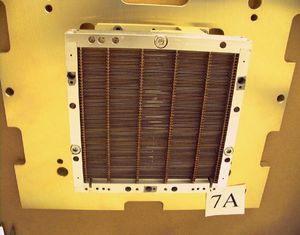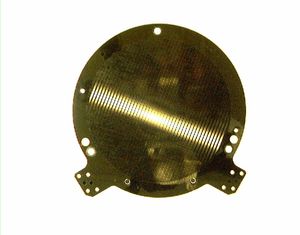RHESSI GRIDS
The key components of the RHESSI imager are two identical sets of nine grids mounted on front and rear grid trays. A corresponding set of nine cooled germanium detectors is mounted behind the rear grids. As the spacecraft rotates at ~15 rpm, the nine rotating modulation collimators time-modulate the incident flux. From the time and energy of counts recorded in the detectors, as well as precise aspect information, images can be reconstructed using software algorithms.
Each grid is a planar array of equally-spaced, X-ray opaque slats separated by transparent slits. The nine subcollimators each consist of a pair of grids with identical pitch and parallel slits separated by 1.55m in front of a detector. The grids have pitches from 34 microns to 2.75 mm and provide a spatial resolution as high as 2.3 arcseconds.
Because of manufacturing considerations, the four finer-pitch grids (1-4) are round and the five coarser-pitch grids (5-9) are square. All are approximately 10cm by 10 cm.

- Photo of Grid 7. The vertical bars are the supports. The 918 micron slit/slat structure runs horizontally.
- Nominal Grid Specifications
- Actual Grid Specifications - G. Hurford
- Same as above in excel format
- 2002 table (Version 3-3) in html, excel (based on pre-flight data)
- Grid Specification Table Explanatory Notes (June 2001)
- Subcollimator Response Calculations (Nov. 2001)
- Grid Information - Photos of grids and more
- The RHESSI Imaging Concept - G. Hurford et al (September(2002)




